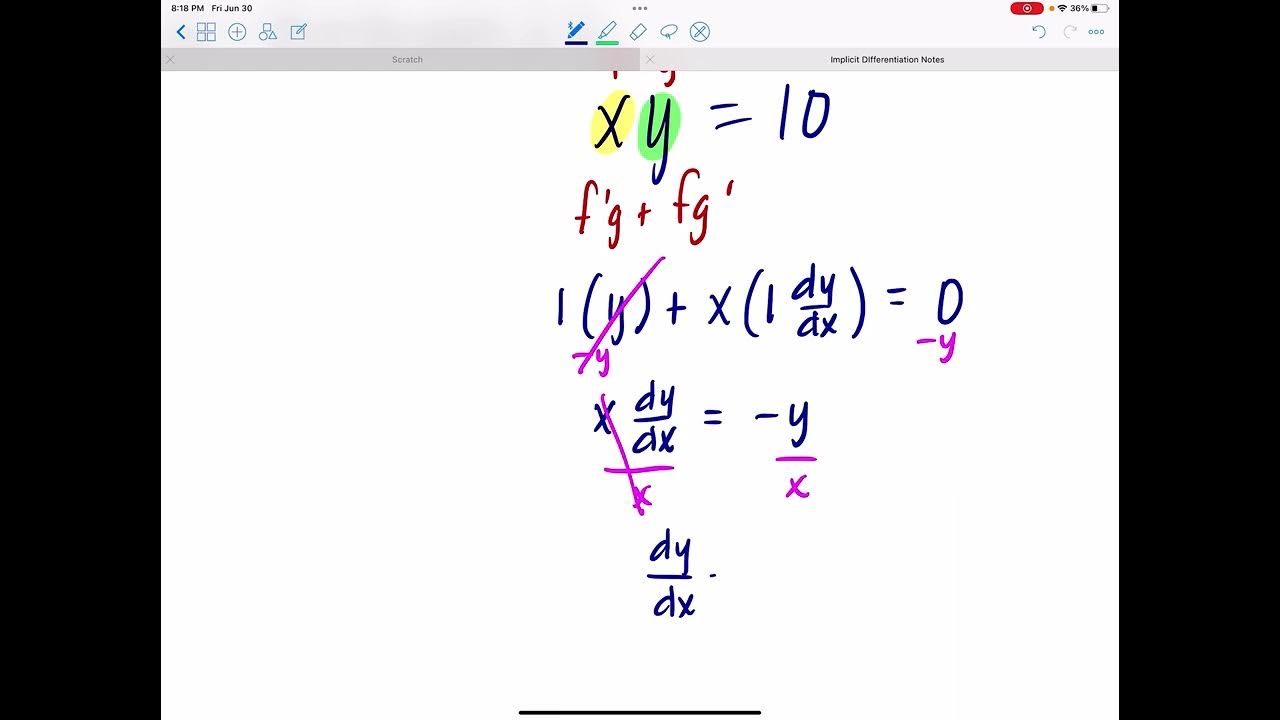Implicit Differentiation
TLDRThis video delves into the concept of implicit differentiation, contrasting it with explicit differentiation. It begins by defining explicit functions, exemplified by y = x^2 + 2x + 3, where y is directly expressed in terms of x. Implicit functions, such as in the equation x^2 + y^2 = 100, are less straightforward to solve for y. The video demonstrates how to differentiate both types of functions, using the chain rule to find the derivative of y with respect to x in the implicit case, resulting in dy/dx = -x/y for the circle equation. It also tackles a more complex example, y = x^x, using logarithmic properties and the chain rule to derive dy/dx. The video concludes with an emphasis on understanding the underlying mathematical concepts and intuition.
Takeaways
- 📚 The distinction between explicit and implicit functions is clarified, with explicit functions directly expressing one variable in terms of another, and implicit functions not doing so straightforwardly.
- 🔢 The process of implicit differentiation is introduced as a method to differentiate equations where the variable of interest is not explicitly defined in terms of the other variable.
- 📈 An example of explicit differentiation is provided using the function y = x^2 + 2x + 3, where the derivative is found by applying the derivative operator to the function.
- 🌀 The concept of implicit differentiation is demonstrated using the equation x^2 + y^2 = 100, where the derivative of y with respect to x is found through a step-by-step process.
- 🤔 The analogy of expressing hunger explicitly or implicitly is used to help understand the difference between explicit and implicit functions in everyday language.
- 📚 The chain rule is explained as a fundamental principle in implicit differentiation, relating the derivative of a function with respect to another variable through the product of the derivative of the outer function with respect to the inner function and the derivative of the inner function with respect to the variable of interest.
- 🧠 The video script provides an intuitive understanding of the chain rule by explaining it as the multiplication of fractions representing small changes in the functions involved.
- 🔄 The process of solving for the derivative of y with respect to x in the circle equation leads to the result dy/dx = -x/y, revealing the relationship between the derivative and the tangent of a circle at any point.
- 🌟 A trick problem involving the function y = x^x is solved using logarithmic properties and implicit differentiation, showcasing a less intuitive application of the technique.
- 📈 The final result of the trick problem, dy/dx = y * (ln(x) + 1), demonstrates the utility of implicit differentiation in finding the derivative of complex functions and the potential for expressing the derivative in different notations.
- 🎓 The video script emphasizes the importance of understanding the intuition behind the mathematical concepts, rather than just memorizing formulas and procedures.
Q & A
What is the main difference between implicit and explicit functions?
-An explicit function defines the variable y explicitly in terms of x, meaning you can directly solve for y by substituting a value for x. An implicit function, however, defines y in a way that does not allow for direct substitution to solve for y; instead, the relationship between x and y is expressed in a way that requires differentiation to solve for y in terms of x.
How does the process of implicit differentiation differ from explicit differentiation?
-In explicit differentiation, you directly apply the derivative operator to the function to find the derivative. Implicit differentiation, on the other hand, involves differentiating both sides of an equation that implicitly defines y in terms of x, using the chain rule to solve for the derivative of y with respect to x.
What is the equation for a circle with a radius of 10, and how does its derivative relate to trigonometry?
-The equation for a circle with a radius of 10 is x^2 + y^2 = 100. The derivative of this circle at any point is given by dy/dx = -x/y. This relates to trigonometry because x corresponds to the cosine and y to the sine of the angle with the x-axis, and the derivative indicates the slope of the tangent line at any point on the circle, which is negative cosine divided by sine.
How can the natural log function be used to simplify the differentiation of y = x^x?
-By taking the natural log of both sides of the equation y = x^x, we obtain ln(y) = x*ln(x). Differentiating both sides with respect to x allows us to use the properties of logarithms and the chain rule to find the derivative of y with respect to x, which simplifies the process compared to direct differentiation of y = x^x.
What is the derivative of y with respect to x for the equation x^2 + y^2 = 100?
-The derivative of y with respect to x for the equation x^2 + y^2 = 100 is dy/dx = -x/y.
What is the significance of the chain rule in implicit differentiation?
-The chain rule is crucial in implicit differentiation as it allows us to find the derivative of a variable (in this case, y) with respect to another variable (x) through an intermediate variable (g). It states that the derivative of a variable with respect to x is equal to the derivative of the intermediate variable with respect to y times the derivative of y with respect to x.
How does the process of implicit differentiation help us understand the relationship between variables in an equation?
-Implicit differentiation helps us understand how one variable changes with respect to another within the context of an equation that does not explicitly solve for one variable in terms of the other. It reveals the rate of change or slope of the relationship between the variables, which is crucial for understanding the behavior of the system described by the equation.
What is the derivative of y with respect to x for the function y = x^x?
-The derivative of y with respect to x for the function y = x^x, after applying the natural log transformation and implicit differentiation, is dy/dx = x^x * (ln(x) + 1).
How does the product rule apply in the differentiation of the natural log of x^x?
-The product rule is applied in the differentiation of the natural log of x^x by considering the natural log of x as one factor and x as the other. The derivative is then computed as the derivative of the first factor (1, since the derivative of x with respect to x is 1) times the second factor, plus the first factor (ln(x)) times the derivative of the second factor (1/x).
What is the purpose of taking the natural log of both sides of an equation during differentiation?
-Taking the natural log of both sides of an equation simplifies the process of differentiation, especially when dealing with complex or non-polynomial functions. It transforms the equation into a form that is easier to differentiate, allowing the use of logarithm properties and the chain rule to find the derivative more efficiently.
How does the concept of 'dy/dx' represent the slope of a curve?
-The notation 'dy/dx' represents the rate of change of y with respect to x, which is the slope of the tangent line to the curve at any given point. It provides a measure of how y changes as x increases, giving us a mathematical description of the steepness or incline of the curve.
Outlines
📚 Introduction to Implicit Differentiation
This paragraph introduces the concept of implicit differentiation, contrasting it with explicit differentiation. It begins by defining an explicit function, where the variable y is clearly defined in terms of x, using the example y = x^2 + 2x + 3. The speaker then explains that implicit functions, such as the equation x^2 + y^2 = 100, do not explicitly define y in terms of x, making it more challenging to solve for y. The paragraph also draws an analogy between explicit and implicit statements in everyday language to help the audience understand the difference. The speaker then transitions into discussing the process of differentiation, specifically highlighting that all previously learned differentiation techniques were explicit, and sets the stage for exploring implicit differentiation.
🔍 Applying the Chain Rule in Implicit Differentiation
In this paragraph, the speaker delves deeper into the process of implicit differentiation by applying the chain rule. The speaker introduces a new function g(y) = y^2 and demonstrates how to take its derivative with respect to x. The chain rule is explained as the product of the derivative of a function with respect to an intermediate variable, and the derivative of that intermediate variable with respect to the original variable. The speaker then applies this rule to the equation x^2 + y^2 = 100, showing that the derivative of y with respect to x is (dy/dx) = -x/y. This result reveals the slope of a circle at any point, relating it to trigonometric functions and the concept of the tangent.
🤔 Reflecting on Implicit Differentiation
The speaker continues the discussion on implicit differentiation by reflecting on the nature of the derivative as a function of both x and y. The paragraph addresses the potential discomfort with having y in the derivative and suggests a substitution method to express the derivative solely in terms of x. The speaker solves for y from the equation x^2 + y^2 = 100 to express dy/dx as a function of x alone. The paragraph also touches on the uniqueness of the plus or minus sign in the derivative and encourages the audience to think about the implications of these results.
🧠 Tackling a Tricky Implicit Differentiation Problem
The final paragraph presents a challenging problem involving implicit differentiation. The speaker introduces the function y = x^x and explains why differentiating it explicitly is difficult. Instead, the speaker uses the natural logarithm to transform the equation into a form that allows for implicit differentiation. The chain rule and properties of logarithms are applied to derive the expression for dy/dx. The speaker then simplifies the expression and suggests a substitution to express the derivative solely in terms of x. The paragraph concludes with the speaker reflecting on the complexity of the problem and its potential to impress in mathematical competitions.
Mindmap
Keywords
💡Implicit Differentiation
💡Explicit Differentiation
💡Derivative
💡Rate of Change
💡Chain Rule
💡Circle
💡Slope
💡Logarithm
💡Natural Logarithm
💡Exponential Function
💡Product Rule
Highlights
Introduction to implicit differentiation and its contrast with explicit differentiation.
Explanation of explicit differentiation using the function y = x^2 + 2x + 3.
Example of implicit differentiation with the equation x^2 + y^2 = 100.
The concept of differentiating both sides of an equation with respect to x.
Derivation of the derivative formula for the circle's equation x^2 + y^2 = 100.
Interpretation of the derivative as the slope of the circle at any given point.
The chain rule's application in implicit differentiation and its intuitive explanation.
Rewriting the equation y = x^x as a logarithmic form for easier differentiation.
Use of logarithm properties to simplify the differentiation process.
Implicit differentiation of the natural log form of the equation y = x^x.
Derivation of the derivative formula dy/dx = y * (ln(x) + 1) / x for the function y = x^x.
Substitution of y back into the derivative formula to express it in terms of x.
The potential of implicit differentiation to reveal complex relationships in functions.
The demonstration of the power rule's limitations in certain differentiation scenarios.
The product rule's application in the differentiation process.
The simplification of complex derivatives into more manageable forms.
The potential of implicit differentiation to be encountered in advanced math exams and competitions.
The conclusion that emphasizes the importance of understanding the underlying concepts in differentiation.
Transcripts
5.0 / 5 (0 votes)
Thanks for rating:





